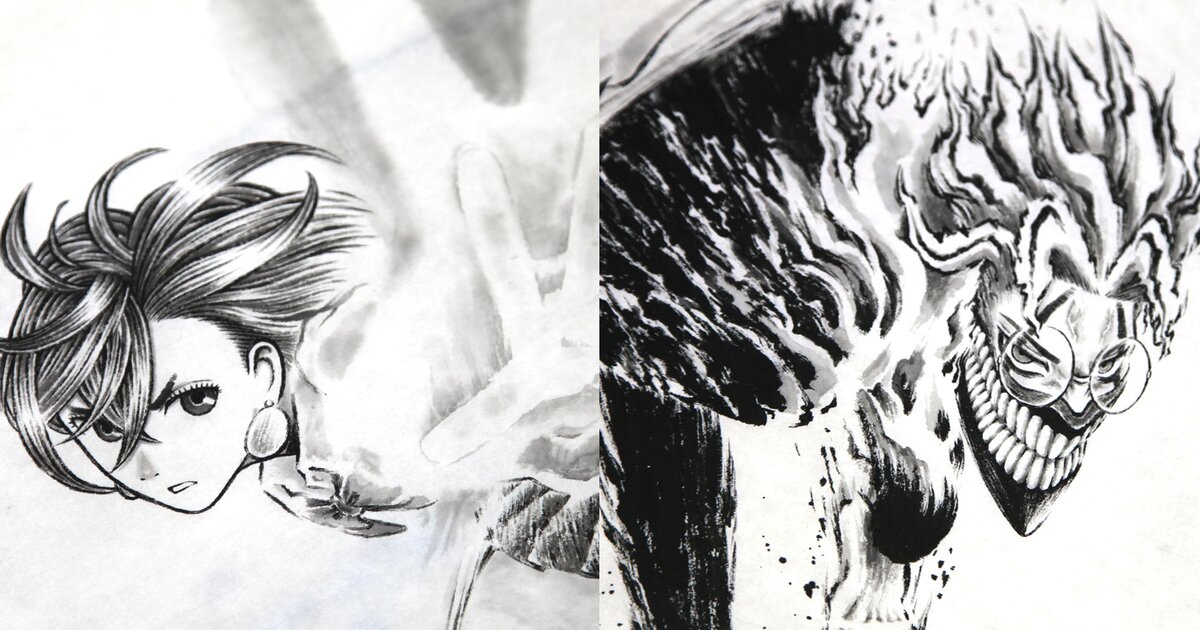
You’ve seen them in anime or in dramas: kakejiku. They’re the wall scrolls you see in the alcoves in Japanese rooms; they’re an indispensable part of a traditional Japanese home. But very few people know much about them, even within Japan.
To celebrate the release of the DAN DA DAN kakejiku, TOM was able to sit down and speak to both the artist, Kazufumi Nishijima, and Taku Okazaki, the CEO of Kaitakudo Art, about the history and creation process of kakejiku.
First, let’s hear about what a kakejiku is and about its history from Mr. Okazaki.
TOM: First of all, what is a “kakejiku”?
Mr. Okazaki: They’re wall scrolls that came to Japan from China, where they were made as tools to spread Buddhist teachings. It was difficult or impossible to build statues to travel so far, so instead, the monks made portable art pieces: kakejiku. Eventually, they began being made with art of scenery, trees, birds, and other decorative and pleasant sights. They ended up transforming from educational tools into pieces of interior decoration as time went by.
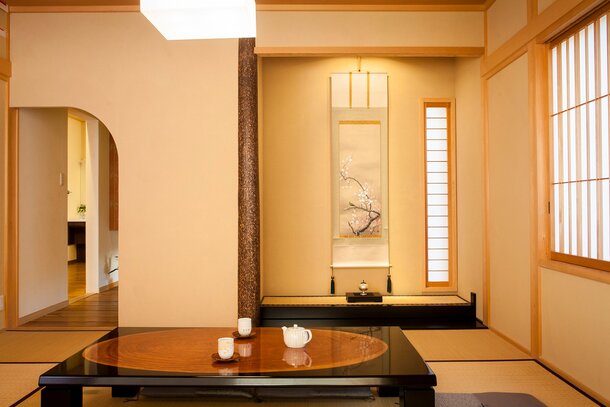
TOM: What place and value do kakejiku have within Japanese culture?
Mr. Okazaki: They were used from the Warring States to the Edo Period. Sen no Rikyu, the tea master known for being the biggest influence on the Japanese art of tea ceremony, was the first to use them to decorate tea rooms. They were considered to be one of the most important tools in a tea party, as it became customary to start the party with discussions about the kakejiku. In fact, kakejiku were so important that when you were building a new room in your home, you would choose the size of the room based on the size of the kakejiku you were planning to display in there.
Kakejiku are made to be changed, so you’d build up a collection of them over generations, as they were also family treasures. In the Edo period, it was trendy to change them out seasonally, something that has remained to this day.
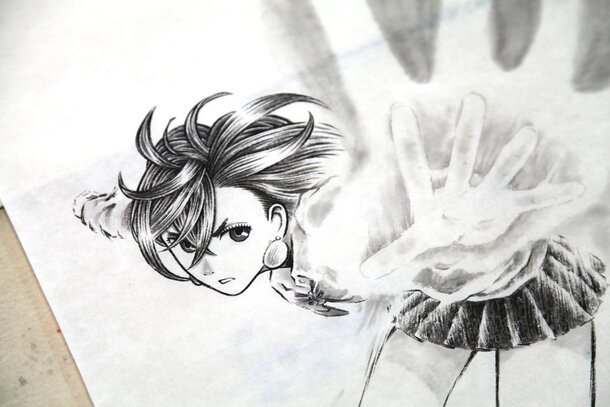
TOM: What do you want foreigners to know about Kakejiku?
Mr. Okazaki: The first thing I want everyone to know is that they can be rolled up. I’ve had customers come in and not know that the kakejiku can be made to be quite compact and easy to carry. In fact, by rolling them up, the art piece inside is stretched out and protected by the fabric, so they should be rolled up for storage.
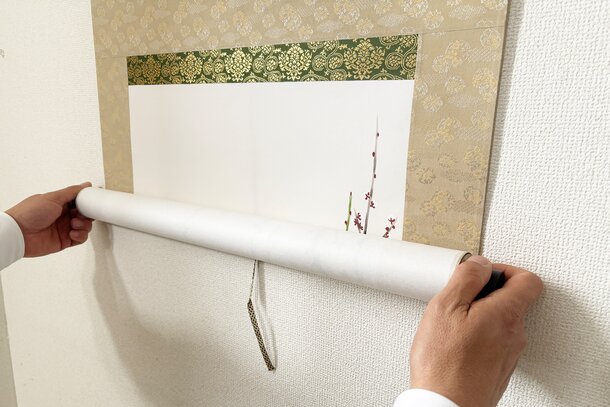
TOM: What are some of the charms of kakejiku that you want foreigners to notice?
Mr. Okazaki: First of all, kakejiku are extremely Japanese. Every museum has a ton of kakejiku on display, especially when it comes to very old pieces of art. It’s a very important form of preserving art, and is one of the best and easiest ways to view and display it as well. Its creation is very efficient and kakejiku themselves can be made to be compact and light. For example, European artists have to deal with heavy frames and canvases, so safely transporting their art can be difficult and expensive. However, kakejiku can simply be rolled up and transported in suitcases.
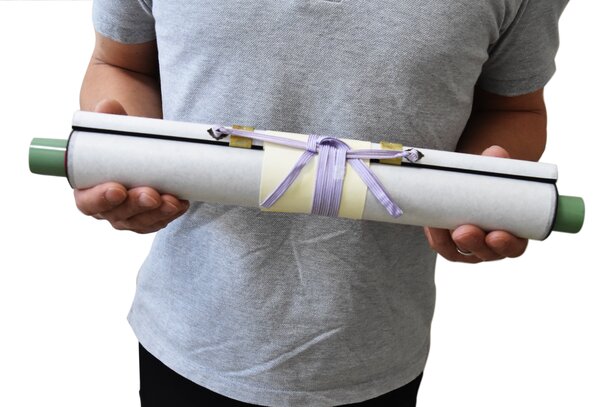
TOM: Despite the fact that they’re so compact, kakejiku are relatively expensive. Can you please tell me why?
Mr. Okazaki: One of the reasons is that it’s made with a variety of different materials. Of course, there’s the paper and the paint for the actual art. But then, the paper used for the backing is a different type of paper, on top of the multiple kinds of fabric also used. Then there’s the glue, the actual roll for the scroll, and the metal parts used for the roll so it doesn’t pop out, which are all developed separately. None of these items are mass manufactured, which makes every item that goes into the creation of a kakejiku expensive. Not only that, but they’re expected to last for eighty to a hundred years, so they are of high-quality materials. The creation process of kakejiku has stayed the same way since the Muromachi period (1336-1573). By the way, creating and repairing kakejiku is considered to be one job because to repair or restore a kakejiku is to essentially pull it apart into its separate pieces and put it back together with updated materials.
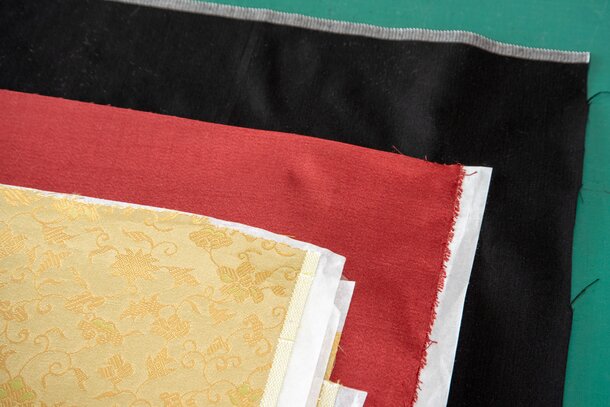
TOM: What do you think of the fusion between traditional Japanese art and anime?
Mr. Okazaki: I think it’s wonderful. In the Edo period, ukiyo-e art went through a similar trend. It went from being beautiful scenery and naturalistic art to portraits of ladies and courtesans that were then handed down through generations. Anime is a part of Japanese culture that we’re very proud of now, and it’s something that we can pass down through generations just like ukiyo-e. Specifically to DAN DA DAN, it’s actually quite a Japanese story. There’s a lot of scenes in it that look just like Japanese art and its story treasures Japanese culture.
TOM: What feelings does your company, Kaitakudo Art, put into the kakejiku you make?
Mr. Okazaki: Most traditional art has changed over the years to match the modern eras, but kakejiku have remained the same. I want to change that. I want to create a revolution in kakejiku and make them match modern lifestyles and trends to make them pieces of art that are easy to purchase and enjoy in a contemporary home. There are also different techniques used to make kakejiku, so I want to be able to choose which technique works best for each specific kakejiku and its purpose.
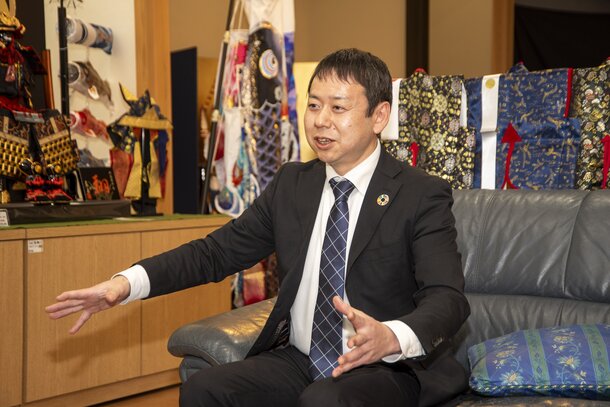
TOM: What makes Kaitakudo Art such a strong player in the kakejiku field?
Mr. Okazaki: Honestly, the many people who work here at Kaitakudo Art work together as one large team. Usually, artisans and illustrators are lone wolves. They work separately and simply submit their work to each other. But here at Kaitakudo Art, we are a team and we work as such, from the illustrators to the salesmen. Having the company work as one big team means that we are all aware of each other’s tasks and that lets us take on collaborations together due to our understanding of each other and our work.
TOM: Finally, could you please give a final word to the fans?
Mr. Okazaki: The kakejiku that we were able to make is truly a wonderful piece of art. I would love for everyone to be able to get their own and decorate their house in it, enjoy what it looks like in their own home. DAN DA DAN is a super fun anime and manga and I want more people to watch it. I want it to be a series that is known globally. I would be honored if our kakejiku could help make that happen.
---------
The TOM team was lucky enough to be offered a tour in the factory where they make kakejiku. Each piece of the process is essentially done by hand, though there are times when they use machinery, such as presses and steamers. However, those machines are basically tools to be able to work on a larger number of pieces at a time, and nothing is really automated! It was incredible to see the craftsmanship that goes into making kakejiku. All of the different art pieces they were working on, from religious Buddhist pieces to traditional landscapes and even some globally famous series, were all made with the same care and artistry. We can expect the same from the DAN DA DAN piece.
As said earlier, we also spoke to Kazufumi Nishijima, the artist behind the incredible illustration of the DAN DA DAN kakejiku, about his work.
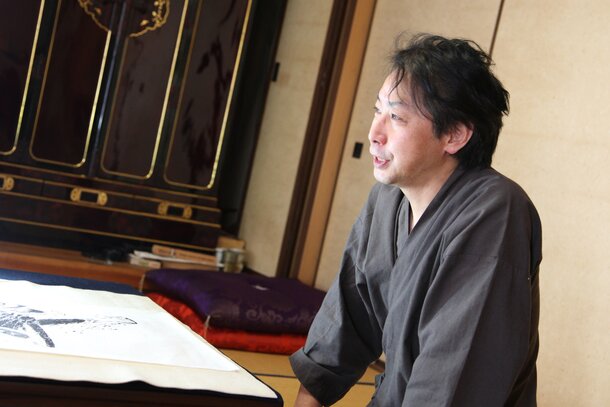
TOM: Can we ask you about your history as an artist?
Mr. Nishijima: I started in 1988 and ever since then, I’ve focused on kakejiku.
TOM: How has your work been received throughout your career?
Mr. Nishijima: Well, I’ve continued making kakejiku for more than thirty years now, so I’m very lucky to have had fans and supporters for my entire career. Modern kakejiku don’t usually get exhibits the way you’d see paintings in a gallery, but I’ve had my work exhibited at shops for sales purposes.
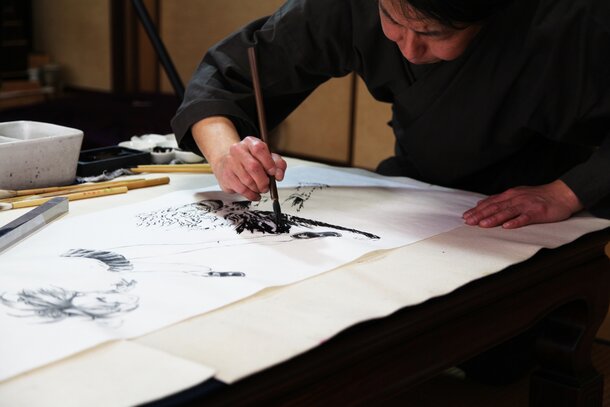
TOM: What motifs do you usually see on kakejiku?
Mr. Nishijima: You often see what is called “kachouga,” which is a genre of flowers and birds on kakejiku, as well as landscapes such as mountain scenes. Those kinds of naturalistic motifs are often seen on kakejiku.
TOM: Well, the kakejiku you made for DAN DA DAN is really different from the traditional motifs, so were there any differences in how you painted the piece?
Mr. Nishijima: For example, with birds and trees, I do a lot of research and sketch lots of drafts to make sure I’m getting everything right. However, when I worked on the DAN DA DAN kakejiku, I read the manga and watched the anime. Actually, I already loved the series before I received the offer to work on this, so I had a lot of fun.
TOM: I have an image of kakejiku of the motifs being rather quiet, but the DAN DA DAN piece is very dynamic.
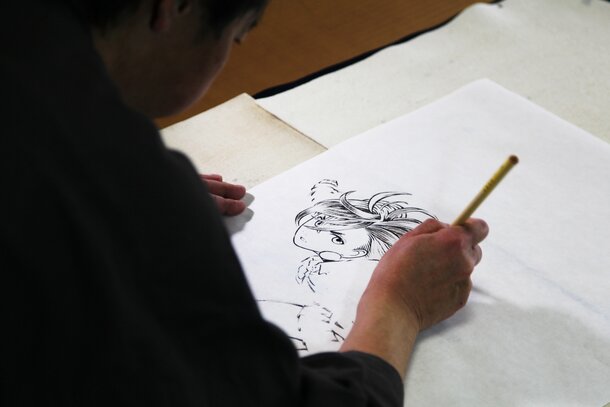
Mr. Nishijima: Yes. Usually there isn’t much movement in the elegant landscapes, but I wanted to take a single moment where you could see both of their movements.
TOM: You said you were a fan of DAN DA DAN from early on in the manga’s run. What was your impression when you first read it?
Mr. Nishijima: I was blown away from the start. I knew there was something special about it. The anime was also amazing, from the dynamic action scenes to how clearly it respects the original manga.
TOM: I’ve seen a number of series by Science SARU, the production company that created the DAN DA DAN anime, and while you can clearly see Science SARU’s touch on the anime, it’s also very evident how much it was made with respect for the manga.
Mr. Nishijima: The anime has a lot of inside jokes that are quite enjoyable for people of my age, so that made it really fun to watch.
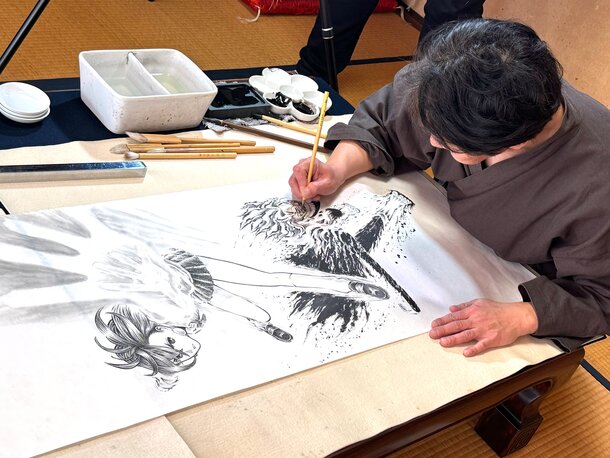
TOM: You said you wanted to show both of their movements in this art, but how did you choose to design this piece in particular?
Mr. Nishijima: A regular illustration is A4-size, but a kakejiku is vertical so I had to work on the drafts to figure out how to show both of them running together. However, having both of them simply standing next to each other wouldn’t bring out the speed that is a vital part of DAN DA DAN, so I decided to have them cross like this.
TOM: What kind of techniques typical of Japanese art did you use on this piece?
Mr. Nishijima: It uses only one color of ink, so I used texture to bring out the colors and dynamism. For example, I used water on the hand to create the blurry effect. Also, for the splashes around Okarun’s feet, I used a technique called “tobashi” where I tap a wet brush on my finger to make drops of ink spray on the paper. I often use that technique in traditional art for pieces that have motifs like dragons as well.
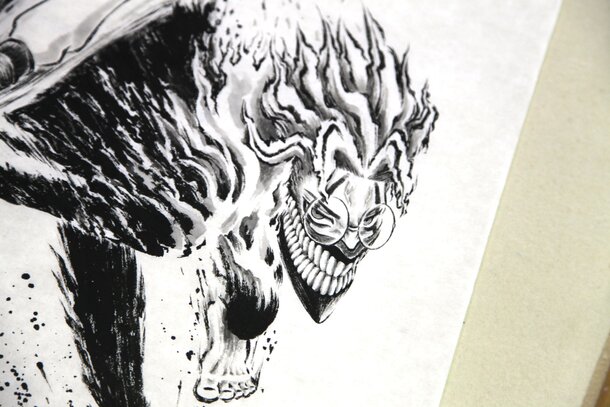
TOM: What is the difficulty in using that kind of traditional technique for an anime illustration?
Mr. Nishijima: There’s no difficulty with the actual art because the techniques work for any kind of motif, but when I’m working on an anime illustration, I get really into the anime and then I think really hard about how I should bring the anime’s expressiveness into the work. I can’t put the whole anime into one illustration, so I must think about how to represent the series best.
Mr. Nishijima: Yes, it is.
TOM: How long did it take to produce this illustration?
Mr. Nishijima: Well, I started last year… I think it took about four months. Painting one doesn’t take too long, but I sketch lots of drafts until I’m happy with the design. I couldn’t tell you an average time of production because it honestly depends on the series and the illustration itself.
TOM: Is it difficult working on drafts like that?
Mr. Nishijima: I continue drawing and drawing until I’m happy with it, but the feeling when I finally get it right is such a joyful sense of accomplishment that it makes it all worth it. I don’t really feel like it’s difficult or hard to work on in general.
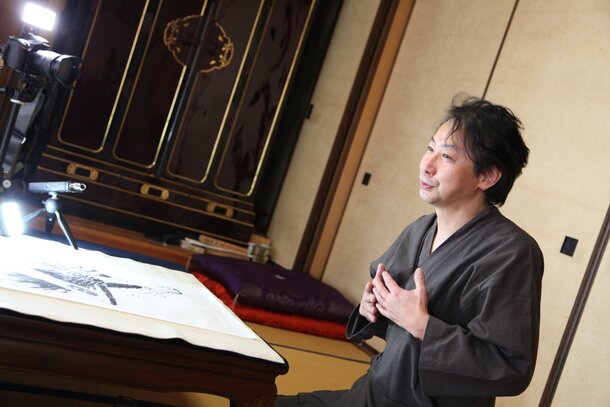
TOM: What other anime genres do you like?
Mr. Nishijima: I like mecha anime a lot. I’ve always loved sci-fi, including novels, so I gravitate to that. But there aren’t many collaborations between sci-fi and Japanese traditional art, so I don’t get to draw it very much. I’d love to, though.
TOM: Do you usually start with a series from the manga or from the anime?
Mr. Nishijima: If there’s an anime that gets huge attention, I’ll read the manga, but in general I tend to start from the manga. It takes less time than watching a whole series.
TOM: Do you draw anime illustrations in your private life?
Mr. Nishijima: I usually draw original work.
TOM: Please send a message to those purchasing this kakejiku.
Mr. Nishijima: Personally, I really love DAN DA DAN and I’ve been reading it from the beginning. I enjoyed the anime a lot as well, so I drew this artwork with the desire to have other fans enjoy both the series as much as I do. As an anime and manga fan, I’d love to keep making more of these, so please enjoy this kakejiku with me.
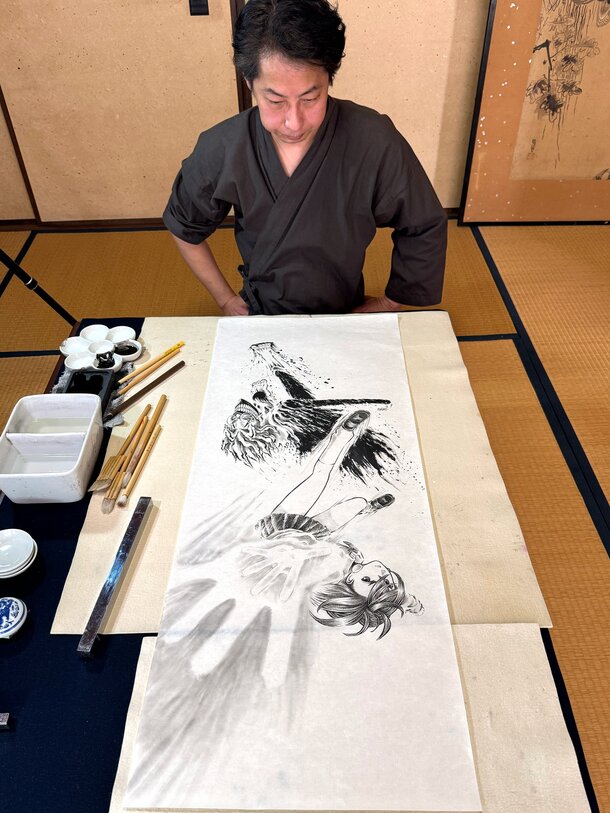
It was a joy to be able to speak to both Mr. Okazaki and Mr. Nishijima. The illustration for DAN DA DAN kakejiku is a sight to behold in person; please make sure to pick up your own! Yeah, it might be a little on the expensive side for merchandise, but as it’s been said, this is supposed to be a family treasure. If you take good care of it, you’ll be able to hand this down in 70 years to your kids or your sibling’s kids or even your local university anime club if you want - whatever the choice, this kakejiku will be there, ready to show the next generation the power that Momo and Okarun hold.
As you all know, here at TOM our motto is to enjoy otaku life. Being able to sit down and meet with these two giants in the traditional Japanese art field and learn that they also enjoy anime and want to merge the two media together is not only a testament to how big anime has gotten, but also gives hope for future collaborations between popular anime and traditional art. As anime fans, this is a great opportunity to support craftsmen as well as your favorite series by obtaining a treasure that you’ll be able to enjoy for the rest of your life - don’t miss it!
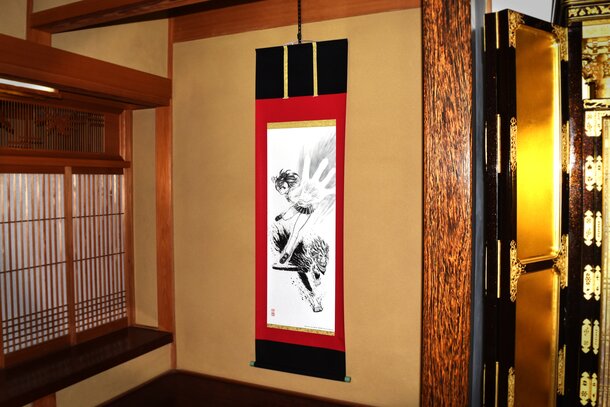
Special Product Page
https://otakumode.com/shop/special/hangingscroll-dandadan
Pre-order your DAN DA DAN Kakejiku Standard ver. or Special ver. today from the TOM Shop.
©Yukinobu Tatsu/SHUEISHA, DANDADAN Production Committee
from Tokyo Otaku Mode News https://ift.tt/OV9AzWF